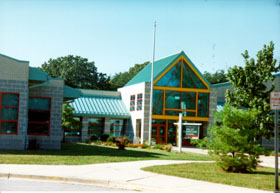
Solley Elementary School, Pasadena, Maryland, October 2000. Photo by Diane F. Evartt.
The Maryland school year is a minimum 180 days long. Schools are open for a ten-month period, from about Labor Day to mid-June. Opening and closing dates vary from county to county. Kindergarten is mandatory. The State also requires that children, ages 5 to 16, attend school. Elementary and middle school students attend school at least 6 hours a day, high school students 6.5 hours a day. Students may attend school up to age 21.
In September 1999, for prekindergarden through high school, 846,582 students enrolled in 1,326 public schools, and 181,086 students enrolled at 1,113 private schools. Public high schools graduated 46,821 students in 1999. Those intending to continue their education: 75.8% (73.2% in a college or university, 2.6% in a trade or business school); to work: 11.5%; to enter military service: 3.7%.
In 1992, the State set more stringent requirements for graduation from high school. Credits required were increased from 20 to 21. General requirements were replaced with particular courses, or courses with specific content. Fewer credits were reserved for electives (nonrequired courses chosen by students). Students must pass functional tests in reading, writing, mathematics, and citizenship. They also must perform 75 hours of volunteer community service approved by the State.
Maryland students consistently excel on national tests. Some 27,941 Maryland public high school seniors (65%) took the Scholastic Assessment Test (SAT) in 1999, a high participation rate.
Special Public School Programs. These cover prekindergarten for four-year olds; and career and technology education, including consumer and homemaking classes. Gifted and talented programs also are offered by the State, on a tuition basis, at summer centers for students who qualify academically, meet geographical distribution requirements, and are able to pay the cost.
Special education services for students with disabilities range from aid for part or all of a school day to specialized services for homebound students or those in separate facilities or hospitals. Within the State Department of Education, the Division of Special Education and Early Intervention Services administers both State and federal programs for special education.
© Copyright April 10, 2001 Maryland State Archives